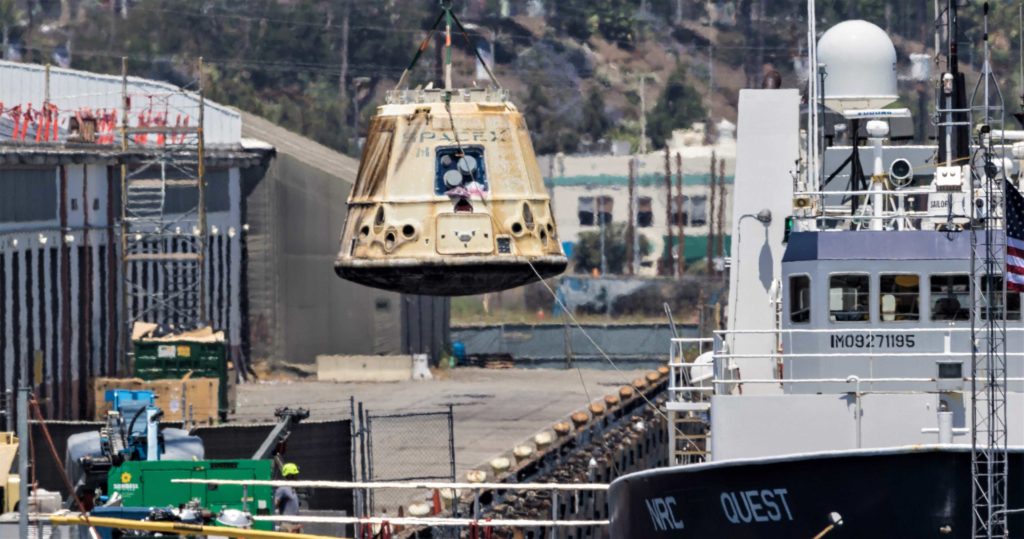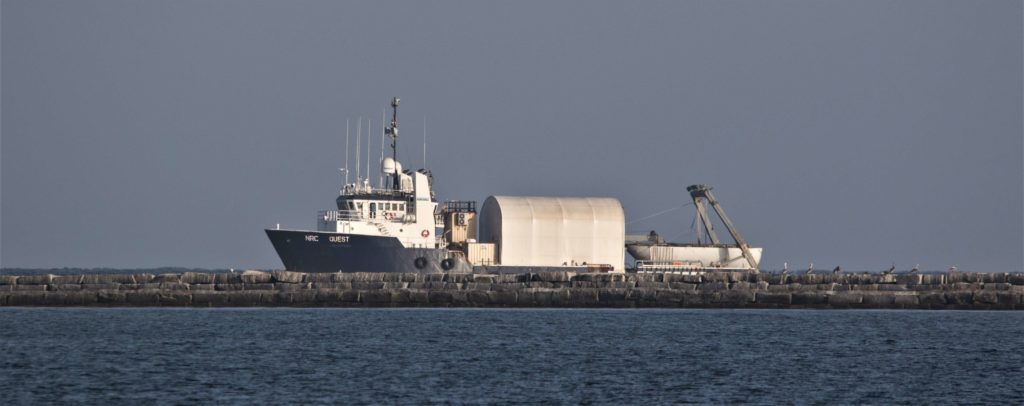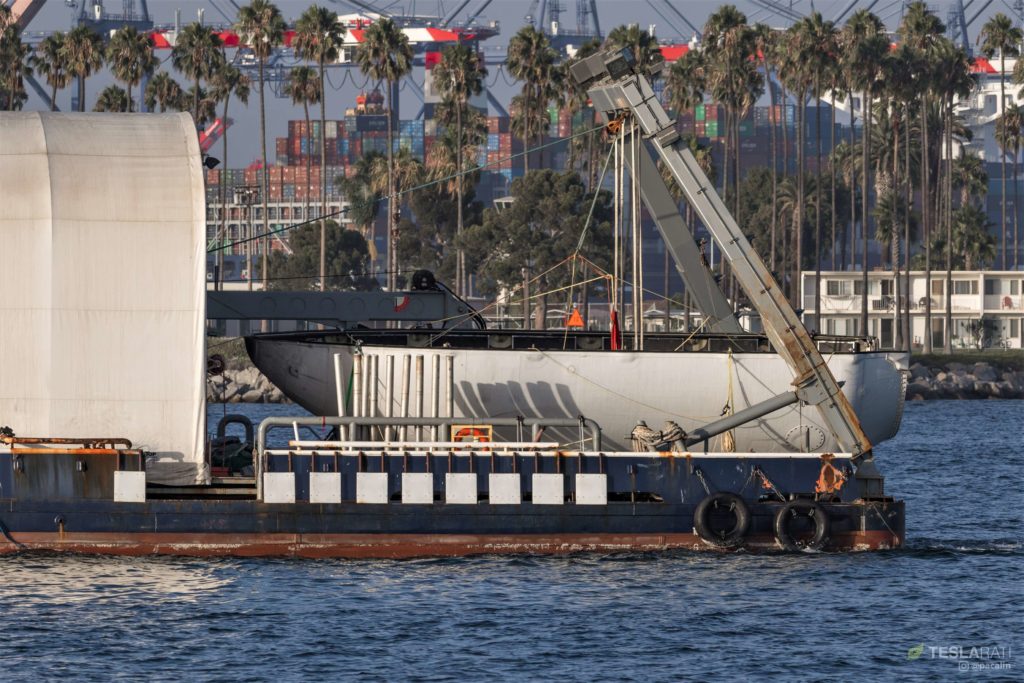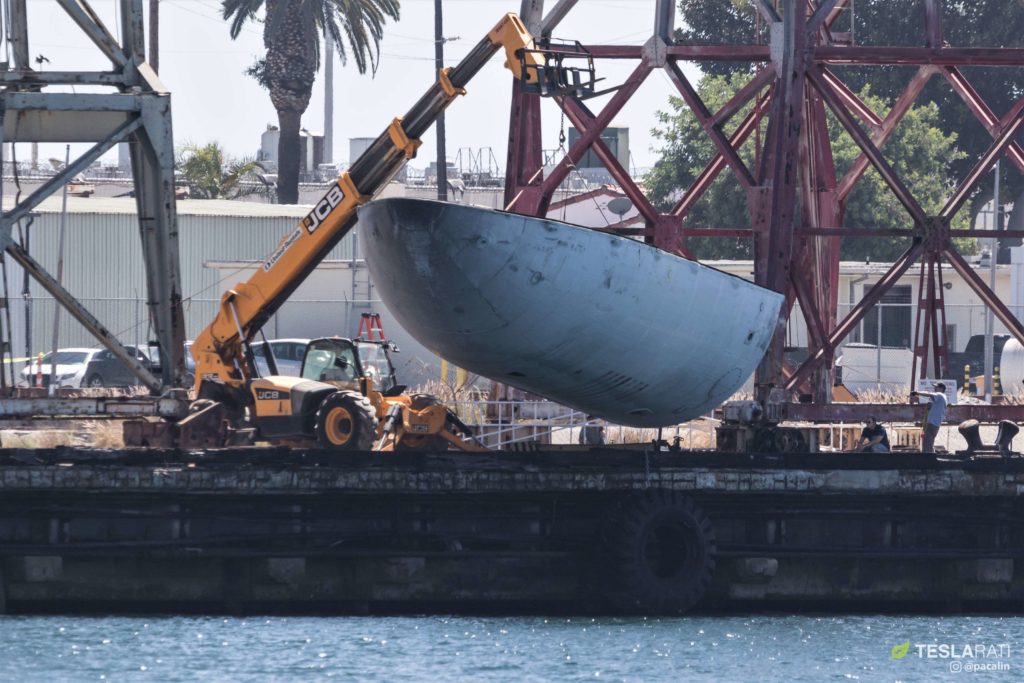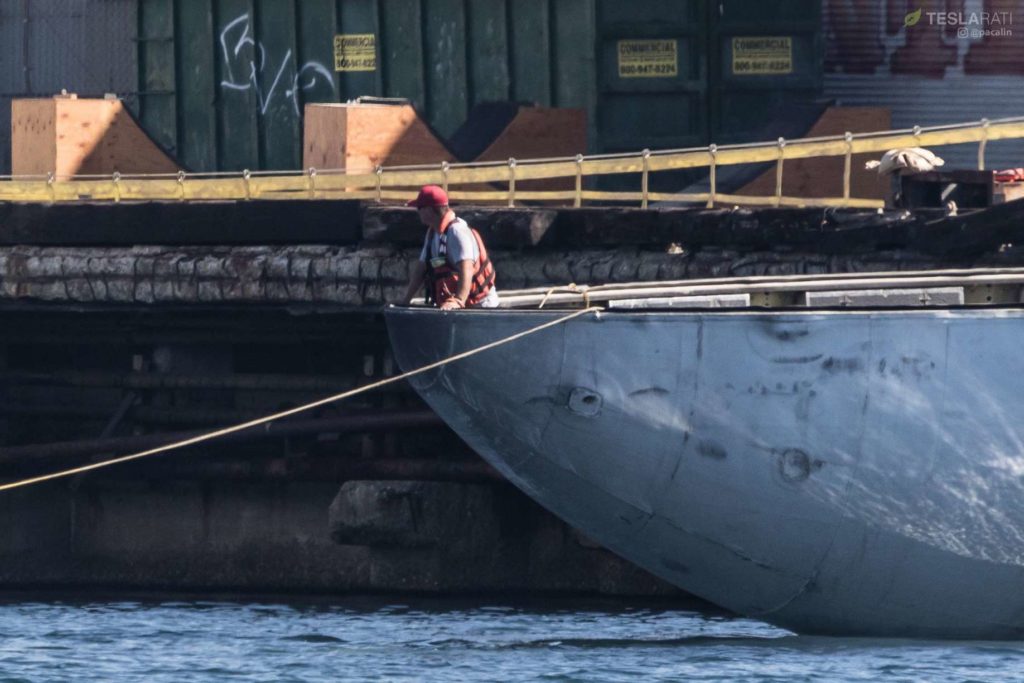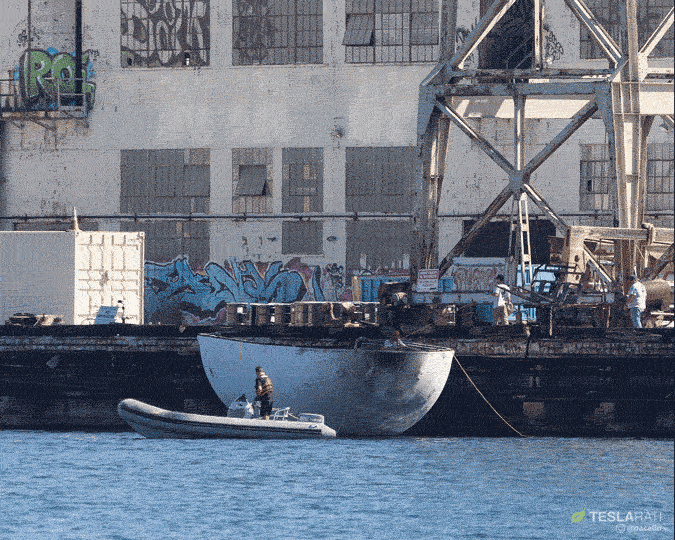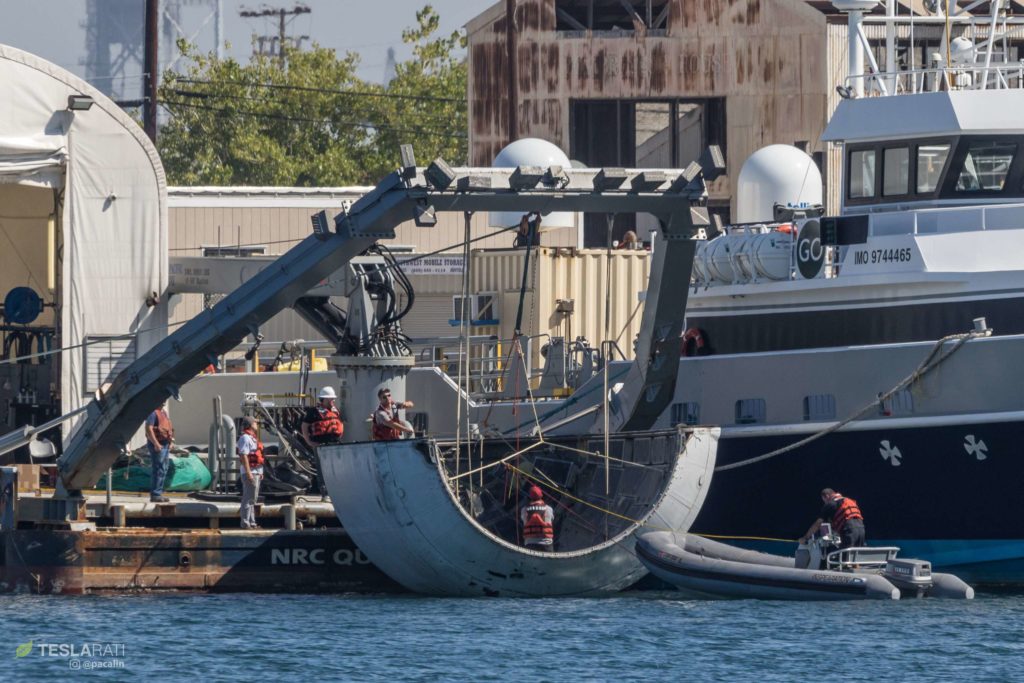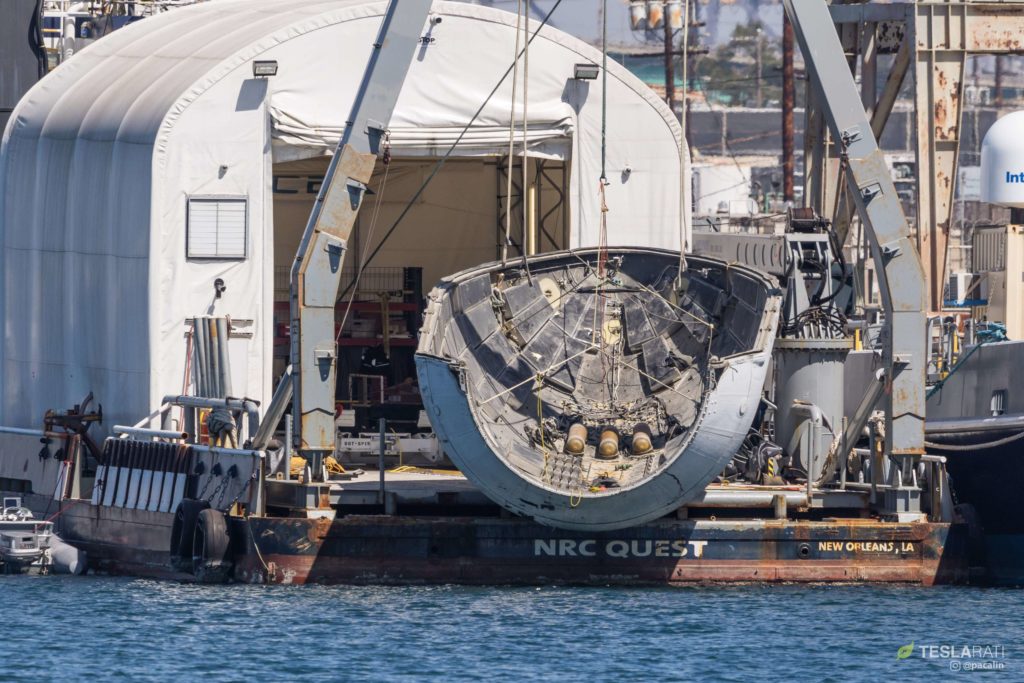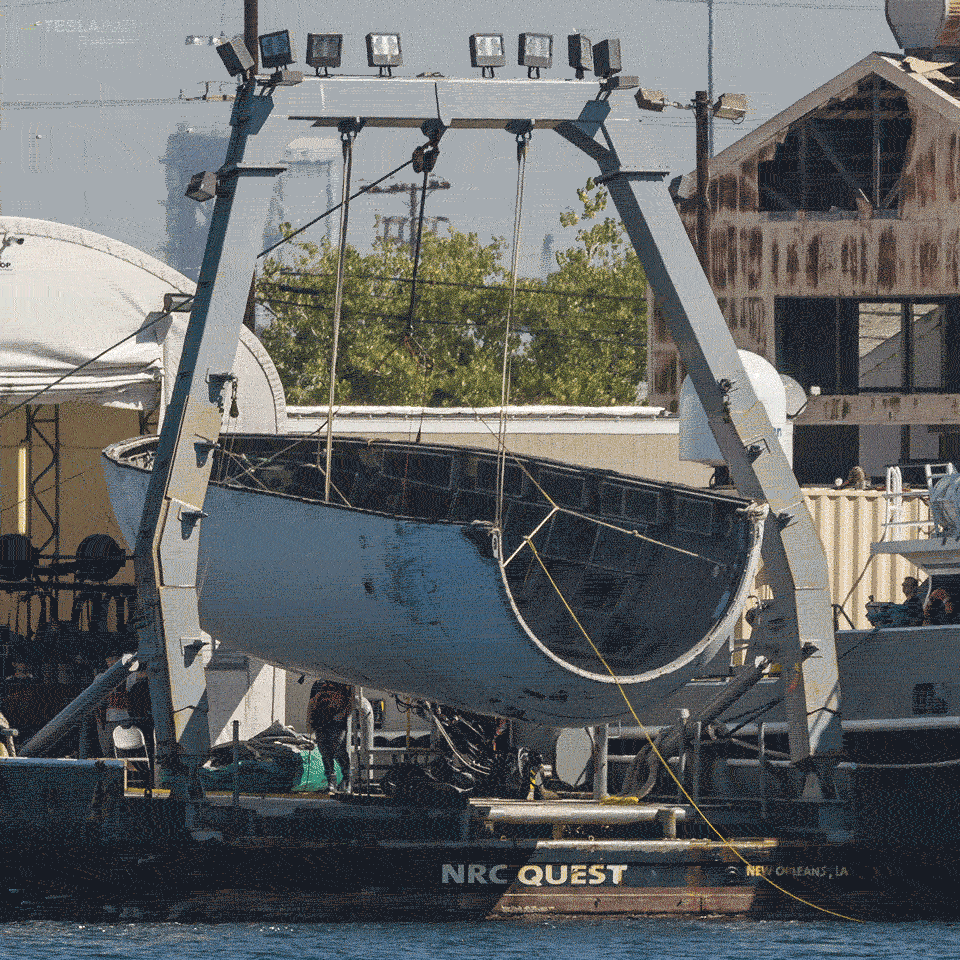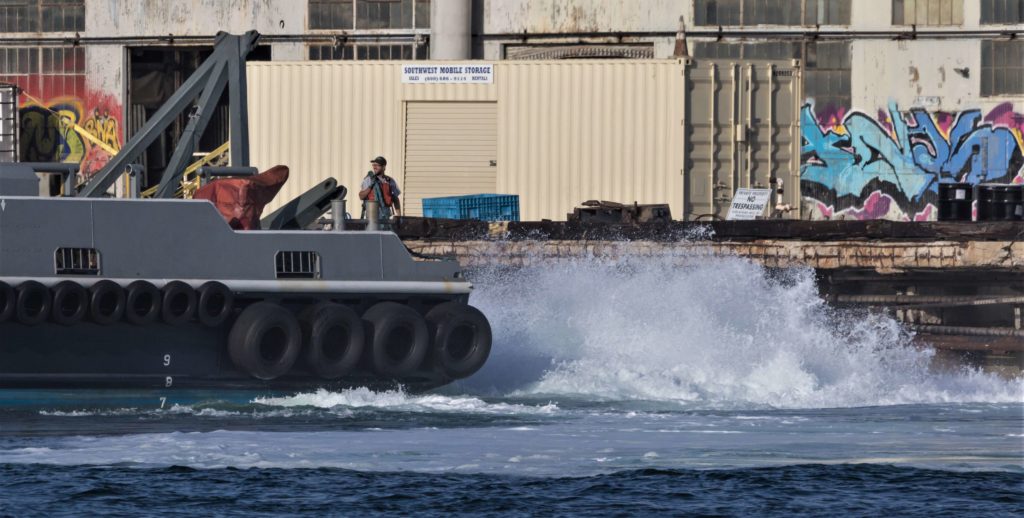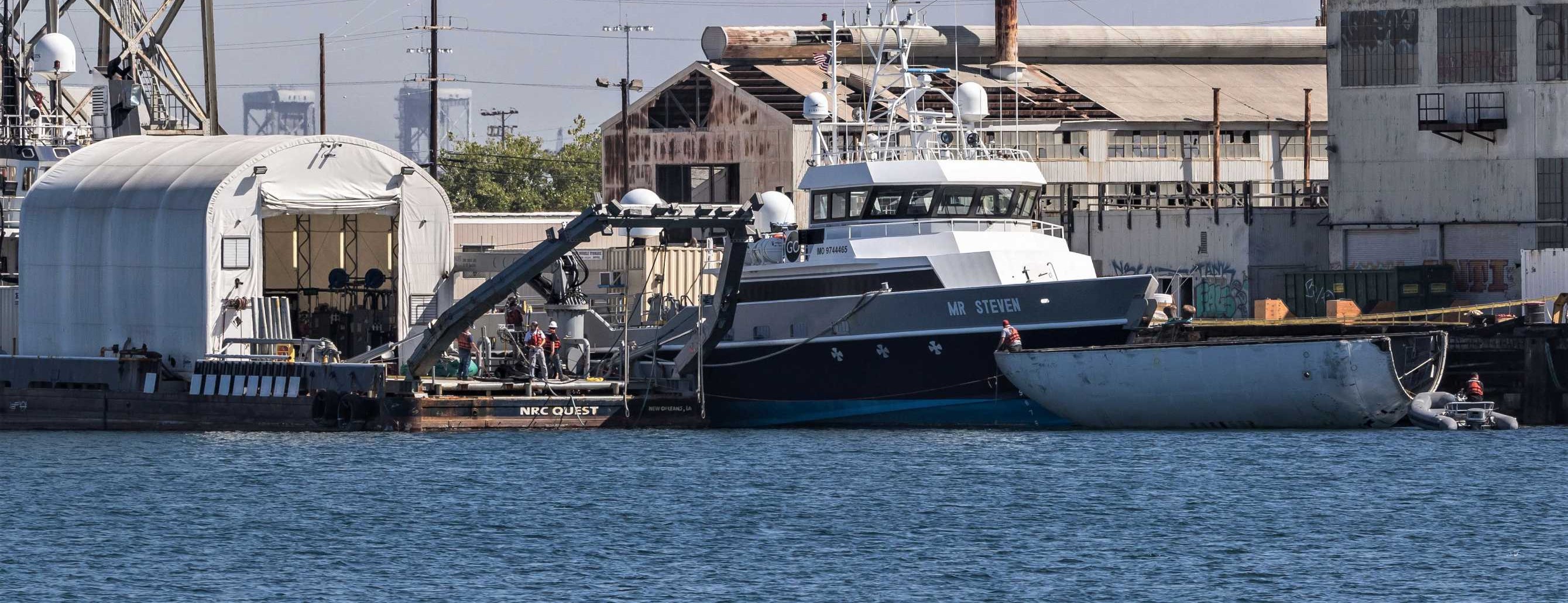

News
SpaceX techs work towards Falcon 9 fairing recovery with wacky series of experiments
Over the course of the past week, Teslarati photographer Pauline Acalin has captured a multitude of unusual occurrences at SpaceX’s Port of Los Angeles dock space, each time involving a Falcon fairing recovery vessel like Mr Steven or NRC Quest, a Falcon fairing half (flight-proven or otherwise), and one of several attenuating circumstances.
More likely than not, what appears as a menagerie of weird and disconnected events on the sidelines is actually a reasonably organized leg of a larger program, in this case focused on experimentation and testing to close the fairing recovery loop and secure Mr Steven’s first successful fairing catch.
From @USCGLosAngeles – A captive carry test involving a helicopter picking an item from a vessel will be conducted 9/20, 11-1300, in the vicinity of San Clemente Island in the San Nicolas Basin. Mariners are requested to maintain a distance of 5NM from the operation. pic.twitter.com/nvy6Wo0IvF
— Marine Exchange (@MXSOCAL) September 19, 2018
The mystery of Catalina Island
Now-iconic fairing recovery vessel (or net-boat, or claw-boat) Mr Steven has been out of commission since late August, at which point SpaceX technicians removed all four of his arms and their eight complementary shock absorber booms towards unknown ends. If SpaceX’s past is any judge, those arms are probably in the process of being upgraded, but it’s impossible to judge thanks to the fact that they have simply disappeared from the Berth 240 docks where they were briefly stored. SpaceX certainly has a way with transporting massive, ungainly objects without stirring a whisper.
Despite lacking arms for more than a month, Mr Steven has still performed a number of sea-trials, ranging from average jaunts a few miles away to a mysterious armless test described in the tweet above. Why exactly Mr Steven was involved in an experiment involving a helicopter “picking an item” – in this case a flight-proven Falcon fairing – off of a vessel while entirely lacking the arms and net he would use to catch said fairing is entirely unclear. Perhaps it was meant to test a datalink or a change to fairing recovery hardware. Whatever transpired, a group of SpaceX technicians certainly flew to Catalina Island and were working alongside or with a Blackhawk helicopter capable of externally carrying up to 3600 kg (8000 lb) of cargo.
- Shortly after completing the CRS-15 resupply mission, Cargo Dragon C110 is craned from NRC Quest to SpaceX’s Port of San Pedro berth, 08/05/18. (Pauline Acalin)
- Mr Steven was out and about conducting high-speed maneuvers two days prior, and also joined NRC Quest near Catalina Island on the 20th. (Pauline Acalin)
- NRC Quest returned to port with a Falcon fairing aboard after a long day doing *something* at sea. (Pauline Acalin)
- Note the sooty tip of the fairing’s nose, a telltale sign that it previously flew on a Falcon 9 launch. (Pauline Acalin)
Multipurpose recovery vessel NRC Quest – nominally dedicated to Cargo Dragon spacecraft recoveries – returned to SpaceX-leased Berth 240 a few hours after the September 20th test window closed, sooty Falcon 9 fairing half in tow. Still, this certainly isn’t the weirdest Falcon fairing-related activity to occur last week.
Fairings aplenty
Meanwhile, over at Mr Steven’s old berth and drone ship Just Read The Instructions’ current berth, a different Falcon fairing half appeared sometime in the last several days in an unusual state, seemingly either fresh out of the factory or in an advanced state of disassembly. The base of this particular fairing half seems to be entirely missing the usual layer(s) of material (cork, among other things) used to waterproof and act as a lightweight heatshield. A new fairing half sitting out in the elements with zero protection would be exceptionally unusual, as CEO Elon Musk has noted that they each cost several million dollars ($3m to be precise), and exposure outside of a cleanroom could very well prevent this half from ever being operationally flown.
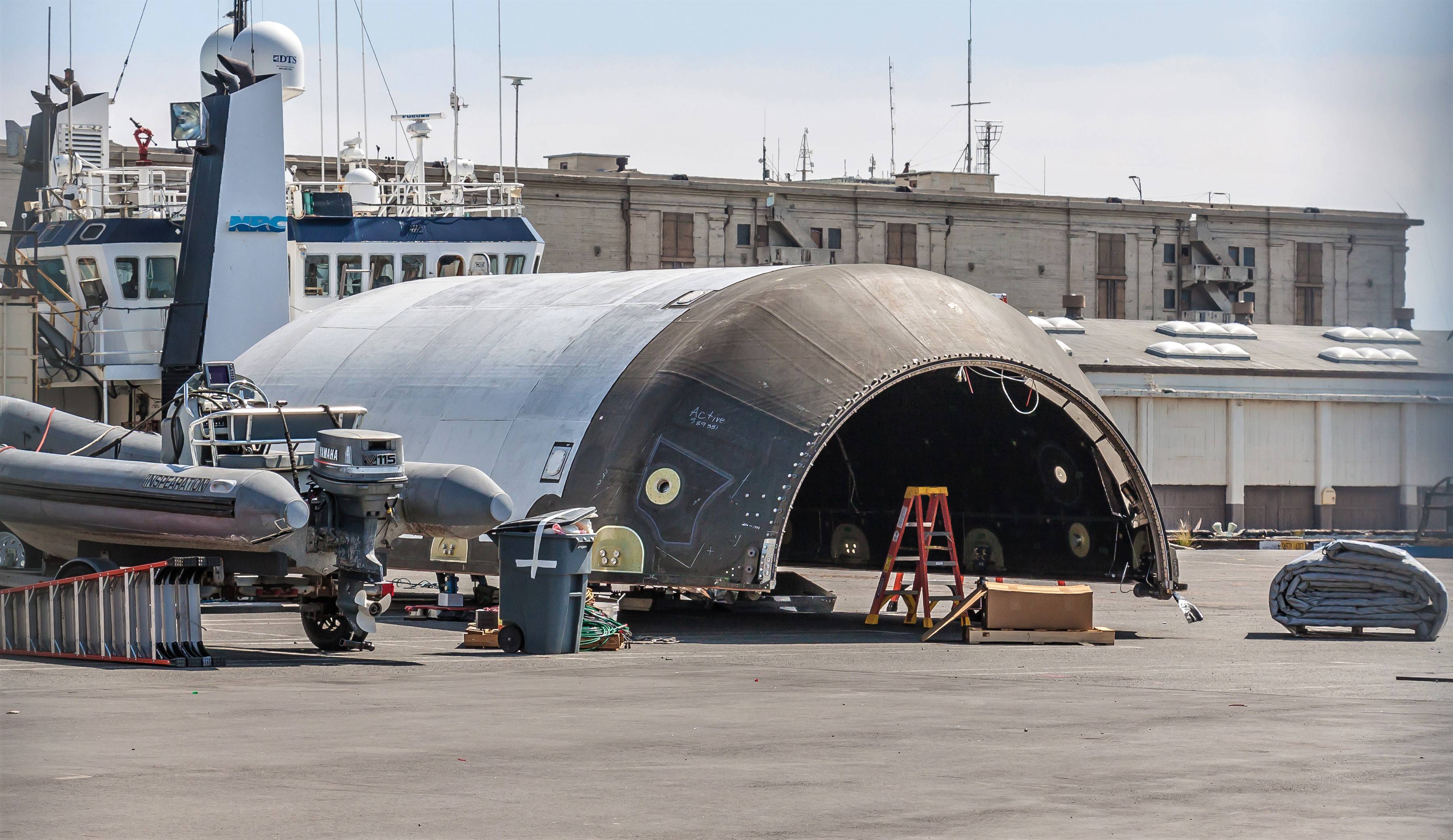
The next best conclusion to be drawn is that this unique fairing half is new or flight-proven (with skin and shielding removed), but sitting at SpaceX’s dock space in order to prepare for one or several active drop tests in pursuit of Mr Steven’s first successful fairing catch. But who really knows, to be honest. The fairing’s bare carbon fiber composite construction is certainly a sight to behold, one way or another.
Doing…something.
This leads us to the grand (perhaps… titanic) finale of wholly unexpected Falcon fairing activities over the last several days. Presumably making the best of an opportunity to test NRC Quest’s ability to recover Falcon fairings after splashdown (i.e. missing Mr Steven’s net), the pictures generally tell the story better than any words ever could. Keep your eyes peeled for Fairing Wrangler job openings.
- Getting the (un)lucky half into the water. (Pauline Acalin)
- One lucky dude. (Pauline Acalin)
- Weeeeeeeeee. (Pauline Acalin)
- NRC Quest then lifted the fairing half (likely from Iridium-7) aboard. (Pauline Acalin)
- NRC Quest then lifted the fairing half (likely from Iridium-7) aboard. (Pauline Acalin)
- This extraordinarily unusual operation lent an opportunity to see just how flexible and structurally optimized SpaceX’s payload fairings are. (Pauline Acalin)
- After returning from a day at sea doing who-knows-what, Mr Steven’s captain attempted to use the 500 metric ton vessel to splash a fellow recovery tech. A for effort. (Pauline Acalin)
Up next for SpaceX, Mr Steven, and the West Coast recovery crew is SAOCOM-1A, scheduled to launch from California’s Vandenberg Air Force Base on the evening (Pacific Time) of October 6th.
For prompt updates, on-the-ground perspectives, and unique glimpses of SpaceX’s rocket recovery fleet check out our brand new LaunchPad and LandingZone newsletters!
Elon Musk
Tesla investors will be shocked by Jim Cramer’s latest assessment
Jim Cramer is now speaking positively about Tesla, especially in terms of its Robotaxi performance and its perception as a company.

Tesla investors will be shocked by analyst Jim Cramer’s latest assessment of the company.
When it comes to Tesla analysts, many of them are consistent. The bulls usually stay the bulls, and the bears usually stay the bears. The notable analysts on each side are Dan Ives and Adam Jonas for the bulls, and Gordon Johnson for the bears.
Jim Cramer is one analyst who does not necessarily fit this mold. Cramer, who hosts CNBC’s Mad Money, has switched his opinion on Tesla stock (NASDAQ: TSLA) many times.
He has been bullish, like he was when he said the stock was a “sleeping giant” two years ago, and he has been bearish, like he was when he said there was “nothing magnificent” about the company just a few months ago.
Now, he is back to being a bull.
Cramer’s comments were related to two key points: how NVIDIA CEO Jensen Huang describes Tesla after working closely with the Company through their transactions, and how it is not a car company, as well as the recent launch of the Robotaxi fleet.
Jensen Huang’s Tesla Narrative
Cramer says that the narrative on quarterly and annual deliveries is overblown, and those who continue to worry about Tesla’s performance on that metric are misled.
“It’s not a car company,” he said.
He went on to say that people like Huang speak highly of Tesla, and that should be enough to deter any true skepticism:
“I believe what Musk says cause Musk is working with Jensen and Jensen’s telling me what’s happening on the other side is pretty amazing.”
Tesla self-driving development gets huge compliment from NVIDIA CEO
Robotaxi Launch
Many media outlets are being extremely negative regarding the early rollout of Tesla’s Robotaxi platform in Austin, Texas.
There have been a handful of small issues, but nothing significant. Cramer says that humans make mistakes in vehicles too, yet, when Tesla’s test phase of the Robotaxi does it, it’s front page news and needs to be magnified.
He said:
“Look, I mean, drivers make mistakes all the time. Why should we hold Tesla to a standard where there can be no mistakes?”
It’s refreshing to hear Cramer speak logically about the Robotaxi fleet, as Tesla has taken every measure to ensure there are no mishaps. There are safety monitors in the passenger seat, and the area of travel is limited, confined to a small number of people.
Tesla is still improving and hopes to remove teleoperators and safety monitors slowly, as CEO Elon Musk said more freedom could be granted within one or two months.
News
Tesla launches ultra-fast V4 Superchargers in China for the first time
Tesla has V4 Superchargers rolling out in China for the first time.

Tesla already has nearly 12,000 Supercharger piles across mainland China. However, the company just initiated the rollout of the ultra-fast V4 Superchargers in China for the first time, bringing its quick-charging piles to the country for the first time since their launch last year.
The first batch of V4 Superchargers is now officially up and running in China, the company announced in a post on Chinese social media outlet Weibo today.
The company said in the post:
“The first batch of Tesla V4 Superchargers are online. Covering more service areas, high-speed charging is more convenient, and six-layer powerful protection such as rain and waterproof makes charging very safe. Simultaneously open to non-Tesla vehicles, and other brands of vehicles can also be charged. There are more than 70,000 Tesla Superchargers worldwide. The charging network layout covers 100% of the provincial capitals and municipalities in mainland China. More V4 Superchargers will be put into use across the country. Optimize the charging experience and improve energy replenishment efficiency. Tesla will accompany you to the mountains, rivers, lakes, and seas with pure electricity!”
The first V4 Superchargers Tesla installed in China are available in four cities across the country: Shanghai, Zhejiang, Gansu, and Chongqing.

Credit: Tesla China
Tesla has over 70,000 Superchargers worldwide. It is the most expansive and robust EV charging network in the world. It’s the main reason why so many companies have chosen to adopt Tesla’s charging connector in North America and Europe.
In China, some EVs can use Tesla Superchargers as well.
The V4 Supercharger is capable of charging vehicles at speeds of up to 325kW for vehicles in North America. This equates to over 1,000 miles per hour of charging.
Elon Musk
Elon Musk hints at when Tesla could reduce Safety Monitors from Robotaxi
Tesla could be reducing Safety Monitors from Robotaxi within ‘a month or two,’ CEO Elon Musk says.

Elon Musk hinted at when Tesla could begin reducing Safety Monitors from its Robotaxis. Safety Monitors are Tesla employees who sit in the front passenger seat during the driverless rides, and are there to ensure safety for occupants during the earliest rides.
Tesla launched its Robotaxi fleet in Austin last Sunday, and after eight days, videos and reviews from those who have ridden in the driverless vehicles have shown that the suite is safe, accurate, and well coordinated. However, there have been a few hiccups, but nothing that has put anyone’s safety in danger.
A vast majority — close to all of the rides — at least according to those who have ridden in the Robotaxi, have been performed without any real need for human intervention. We reported on what was the first intervention last week, as a Safety Monitor had to step in and stop the vehicle in a strange interaction with a UPS truck.
Watch the first true Tesla Robotaxi intervention by safety monitor
The Tesla and UPS delivery truck were going for the same street parking space, and the Tesla began to turn into it. The UPS driver parallel parked into the spot, which was much smaller than his truck. It seemed to be more of an instance of human error instead of the Robotaxi making the wrong move. This is something that the driverless cars will have to deal with because humans are aggressive and sometimes make moves they should not.
The Safety Monitors have not been too active in the vehicles. After all, we’ve only seen that single instance of an intervention. There was also an issue with the sun, when the Tesla braked abnormally due to the glare, but this was an instance where the car handled the scenario and proceeded normally.
With the Robotaxi fleet operating impressively, some are wondering when Tesla will begin scaling back both the Safety Monitors and Teleoperators that it is using to ensure safety with these early rides.
CEO Elon Musk answered the inquiry by stating, “As soon as we feel it is safe to do so. Probably within a month or two.”
As soon as we feel it is safe to do so.
Probably within a month or two. We continue to improve the Tesla AI with each mile driven.
— Elon Musk (@elonmusk) June 30, 2025
Musk’s response seems to confirm that there will be fewer Teleoperators and Safety Monitors in the coming months, but there will still be some within the fleet to ensure safety. Eventually, that number will get to zero.
Reaching a point where Tesla’s Robotaxi is driverless will be another significant milestone for the company and its path to fully autonomous ride-sharing.
Eventually, Tesla will roll out these capabilities to consumer-owned vehicles, offering them a path to generate revenue as their car operates autonomously and completes rides.
For now, Tesla is focusing on perfecting the area of Austin where it is currently offering driverless rides for just $4.20 to a small group of people.
-

 News5 days ago
News5 days agoTesla Robotaxi’s biggest challenge seems to be this one thing
-

 News2 weeks ago
News2 weeks agoTesla confirms massive hardware change for autonomy improvement
-

 Elon Musk2 weeks ago
Elon Musk2 weeks agoElon Musk slams Bloomberg’s shocking xAI cash burn claims
-

 News2 weeks ago
News2 weeks agoTesla features used to flunk 16-year-old’s driver license test
-

 News2 weeks ago
News2 weeks agoTesla China roars back with highest vehicle registrations this Q2 so far
-

 News2 weeks ago
News2 weeks agoTexas lawmakers urge Tesla to delay Austin robotaxi launch to September
-

 News2 weeks ago
News2 weeks agoTesla dominates Cars.com’s Made in America Index with clean sweep
-

 News2 weeks ago
News2 weeks agoTesla’s Grok integration will be more realistic with this cool feature

